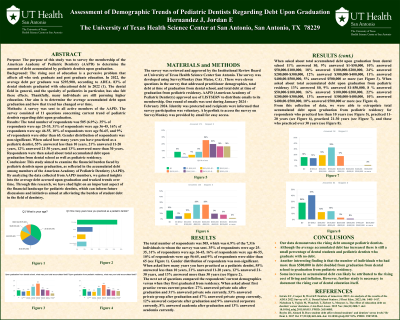Other
353 - Assessment of Demographic Trends of Pediatric Dentists Regarding Debt Upon Graduation

- JH
Jonathan Hernandez, DDS
Resident
University of Texas Health Science Center-San Antonio
University of Texas Health Science Center at San Antonio
Laredo, Texas, United States - EJ
Elva Jordan, DDA
University of Texas Health Science Center-San Antonio
- EJ
Elva Jordan, DDS
Associate Professor
University of Texas Health Science Center-San Antonio
Laredo, Texas, United States - MC
Maria-Jose Cervantes Mendez, DDS MS FAAPD
Program Director
UTHSCSA
San Antonio, Texas, United States
Presenting Author(s)
Co-Author(s)
Research Mentor(s)
Program Director(s)
Assessment of Demographic Trends of Pediatric Dentists Regarding Debt Upon Graduation, Hernandez J, Jordan E, (University of Texas Health Science Center, San Antonio, TX)
Research supported by the University of Texas Health Science Center – San Antonio
Purpose: A national survey of pediatric dentists will be conducted to review pediatric dentists’ demographic trends regarding debt upon graduation.
Methods: A survey was sent to all active members of the AAPD. The survey consisted of 11 questions concerning current trend of pediatric dentists regarding debt upon graduation.
Results: The total number of respondents was 505, which was 6.9% of the 7,316 individuals to whom the survey was sent. 35% of respondents were age 25-35, 31% of respondents were age 36-45, 16% of respondents were age 46-55, 10% of respondents were age 56-65, and 9% of respondents were older than 65. Gender distribution of respondents was non-significant. When asked how many years you have practiced as a pediatric dentist, 55% answered less than 10 years, 21% answered 11-20 years, 12% answered 21-30 years, and 13% answered more than 30 years.
The next set of questions compared the respondents’ current demographics versus when they first graduated from residency. When asked about first practice versus current practice: 27% answered private solo after graduation and 31% answered private solo currently, 53% answered private group after graduation and 47% answered private group currently, 12% answered corporate after graduation and 9% answered corporate currently, 8% answered academia after graduation and 13% answered academia currently.
When asked about total accumulated debt upon graduation from dental school 11% answered $0, 9% answered $1-$50,000, 10% answered $50,000-$100,000, 18% answered $100,000-$200,000, 24% answered $200,000-$300,000, 12% answered $300,000-$400,000, 11% answered $400,00-$500,000, 5% answered $500,000 or more. When asked about total accumulated debt upon graduation from pediatric residency 13% answered $0, 9% answered $1-$50,000, 8 % answered $50,000-$100,000, 16% answered $100,000-$200,000, 22% answered $200,000-$300,000, 13% answered $300,000-$400,000, 10% answered $400,00-$500,000, 10% answered $500,000 or more.
From this collection of data, we were able to extrapolate total accumulated debt upon graduation from pediatric residency for respondents who practiced less than 10 years, practiced 11-20 years, practiced 21-30 years, and those who practiced over 30 years.
Conclusion: This study aimed to examine the financial burden faced by pediatric dentists upon graduation, as reflected in the accumulated debt among members of the American Academy of Pediatric Dentistry (AAPD). By analyzing the data collected from AAPD members, we gained insights into the average debt accrued upon graduation and tracked trends over time. Through this research, we have shed light on an important aspect of the financial landscape for pediatric dentists, which can inform future discussions and initiatives aimed at alleviating the burden of student debt in the field of dentistry.
Identify Supporting Agency and Grant Number:

.jpg)